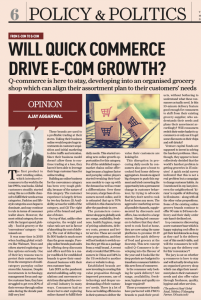Replicating similar experiences to shoppers over the Internet, however, remains a tough challenge for players
Last weekend, I was in Mahabaleshwar, and on the way back, my wife realised that the trip would be incomplete without any Strawberry Cream. We had just had breakfast and were quite full, but knew we couldn’t leave without having some.
So, we stopped at the first clean place we found on the side of the road. It was a Sunday morning and the place was empty. The waiter seemed genuinely happy to see us. Perhaps, they greet the day’s first customers that way, or maybe the courtesy is extended to everyone. As we sat down, the owner came over and asked with enthusiasm how he could serve us.

Now, we weren’t big-ticket customers, all we wanted was Strawberry Cream, but he was excited to have us and promised us the best in town. We were happy with the serving. And as we ate, he came over with a bowl of strawberries freshly picked from his back garden. We hesitated, but he insisted that we ate some. When the bill came, we noticed he hadn’t charged us for it!
This was a small road-side restaurant, and the staffers most definitely hadn’t been formally trained. But because of the owner’s attitude, the waiters were eager to serve and we had a more memorable dining experience than any restaurant or hotel in the city. The next time I am in Mahabaleshwar, I will definitely go back.
The experience got me thinking. We live in a country of owner-run retailers and I wondered whether most of them operate like this and whether it really helps them increase sales. I remembered the story a friend in the US who shared his knowledge about a neighbourhood book shop. The owner has a deep knowledge and love for books and is always around to make suggestions on what to read next based on what customers had last shopped for.
And then, he does something else. While handing you your book and change, he leaves you with a phrase — a command — to come back. “You’ll come back for more soon!” he says confidently and plants a seed of satisfaction that usually turns into return sales.
Most small retailers work with specific tricks and practices to engage with their customer base and continue to grow their sales through goodwill generated and word of mouth. But these are small stores and most have owners who are present on the shop floor every day.
So, is it possible to adopt similar practices in modern retail, where most stores are fronted by employees? That depends on whether people running these stores believe that delivering personal experiences will get customers engaged with their brand. And that eventually, this brand engagement will increase their sale, allowing them to beat their targets at a much lower cost.
A business advisor and colleague runs a fresh fruit and vegetable aggregation and distribution business. On a routine store visit in Pune, he found that a store manager was struggling every day to sell his quota of grapes. It was identified that only 14% of that store’s customers were buying fruits and vegetables in the store. So, he asked that the grapes be made available for tasting at various shopping points, including at the check-out.
The first day they implemented this, the store was out of stock by 3pm! This trick, which cost the store absolutely nothing, also helped them increase their daily sales of fruit and vegetables thereafter.
Most of these practices can be implemented at no extra cost if the importance of delivering shopping experiences takes centre stage within the operational practices of modern retail. Business leaders running these businesses have to adopt this as a core strategy of running a successful and profitable retail business. At KLISMA, for example, our philosophy is simple: there is no single rule
when it comes to meeting customer satisfaction. Each associate is at liberty to make his/her own decisions to deliver desired shopping experiences.
However, bringing similar experiences to shoppers over the Internet is a unique challenge of our times. The key here, for multi channel retailers, will be to build technological tools that enable shoppers to have similar shopping experiences. One way of doing this could be by giving online grocery shoppers a sabzi mandi experience. There could be a tool that would let them bargain for the price of 2kg of potatoes, pick the size of bhindi they prefer, or ask for free dhaniya and mirchi once their basket is full.
This is just one example of providing a purely Indian offline shopping experience to a website, converting e-commerce into experience commerce! In this country, with several people just getting used to the concept of paying online, the scope for such developments is large. All that modern retailers need to ask themselves is why we enjoy shopping in a market, and then translate that into a virtual experience.
From a series of articles commissioned by DNA (Money) dated 25 April 2012.



